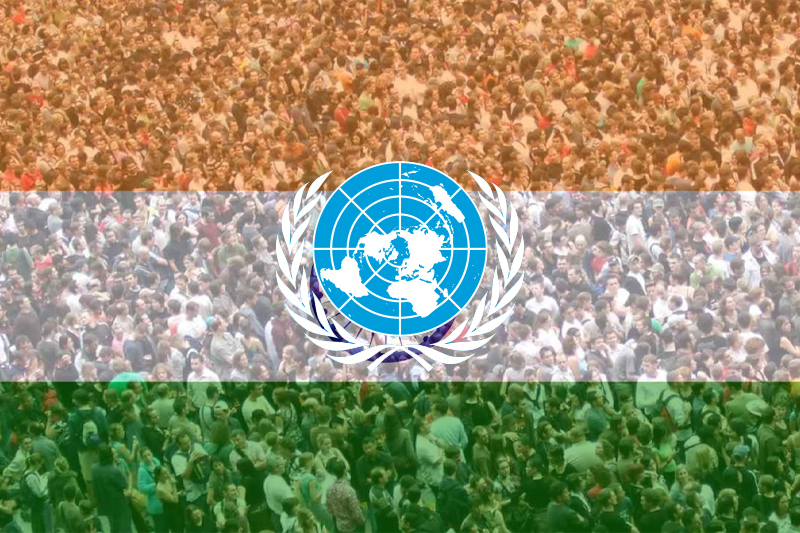
un report reveals india’s population growth how will it affect foreign policy
India’s population is on the rise, and it’s not just a small increase. According to a recent UN report, India is expected to surpass China as the world’s most populous country by 2027. This growth has significant implications for foreign policy, both domestically and internationally. With this in mind, how will India manage its growing population while also navigating global politics? Join us as we explore the potential impacts of India’s population growth on foreign policy in this captivating blog post.
Introduction to the UN Population Report
The United Nations Population Report is an important document that provides data and analysis on global population trends. The report is released every two years, and the most recent edition was released in 2017.
The UN Population Report is a valuable resource for understanding global population trends and their implications for foreign policy. The report provides data on population size, growth rates, urbanization, and fertility rates. It also includes an analysis of these trends and their implications for economic development, environmental sustainability, and social stability.
The UN Population Report is an important tool for policymakers who are trying to understand and address the challenges posed by rapid population growth. India’s population is projected to surpass China’s in 2027, making it the world’s most populous country. This rapid growth will present challenges for India in terms of providing adequate housing, employment opportunities, and infrastructure.
The UN Population Report can help policymakers understand these challenges and develop policies that will encourage sustainable economic development and social stability in India.
UN population report: India’s population has increased by 1.56% in a year to 142.8 crores.
According to the most recent report, India’s total fertility rate—the number of births per woman of childbearing age—is estimated to be 2.0.
According to the most recent State of the World Population (SOWP) report from the UNFPA, India’s population is estimated to be 1,428,600,000 million (142.86 crores), up 1.56% from the previous year. More than two-thirds of this population, or 68%, are people between the ages of 15 and 64, which is regarded as a country’s working population.
A report titled “8 Billion Lives, Infinite Possibilities: the case for Rights and Choices” that was published on Wednesday reveals that China, with a population of 1,425.7 million (142.57 crores), is only slightly larger than India. It was projected to be 1,448.5 million, or 144.85 crores, in 2022.
India had a population of 1406.6 million people in 2022, with 68% of those people being in the 15–64 age range, according to the report.
According to the most recent report, India’s total fertility rate—the number of births per woman of childbearing age—is estimated to be 2.0. According to the report, which has been released yearly since 1978, an Indian male can expect to live to be 71 years old, and an Indian woman can expect to live to be 74.
As the world’s population approaches 8 billion, Andrea Wojnar, Representative, UNFPA India, and Country Director, Bhutan, commented on the report that “we at UNFPA see India’s 1.4 billion people as 1.4 billion opportunities.”
“India’s tale is an inspiring one. It is a tale of improvement in public health and sanitation, economic growth, and technological development. The 254 million youth (15–24 years old) in the nation with the largest youth cohort can contribute original ideas, fresh perspectives, and long-lasting solutions. If women and girls in particular have access to equal educational and skill-building opportunities, technology and digital innovations, and most importantly, the knowledge and power to fully exercise their reproductive rights and choices, the trajectory can leapfrog forward, she said.
According to the report, 44% of partnered women and girls in the 68 countries that provided data cannot make an informed choice about their bodies, including whether to engage in sex, use contraception, or seek medical attention. It states that there is an unmet need for safe, effective contraception among 257 million women worldwide.
Before the release of the flagship report, Dr. Natalia Kanem, Executive Director of UNFPA, stated during a virtual media conference that the world is asking the wrong questions, such as, “Are there too many people in the world? Do you think the world has too few people? Is the rate of population growth appropriate?
She contends that the real question is not how quickly people are reproducing, but rather whether all people and couples are free to exercise their fundamental right to decide whether or not to have children. Kanem responded that the answer to that query is “no.”
According to the report, governments are increasingly implementing policies aimed at increasing, decreasing, or maintaining fertility rates as a result of widespread population anxieties. However, attempts to change fertility rates are frequently fruitless and can harm women’s rights. Women’s bodies shouldn’t be used as slaves to achieve population goals, according to Kanem.
“We must radically rethink how we talk about and plan for population change,” she said. “To build thriving and inclusive societies, regardless of population size.” The report urges politicians and the media to give up exaggerated narratives about population booms and busts and calls for a radical rethink of how population statistics are presented.
“Leaders should ask whether people, especially women, can freely make their own reproductive choices instead of how quickly people are reproducing,” Kanem said. “Too often, the answer is no.
She emphasized that family planning must not be used as a means of empowering individuals or meeting fertility goals. In addition, she argued that women should be free from the influence of experts and authorities to decide whether, when, and how many children they want to have.
Important India insights
To compile the report, UNFPA hired YouGov to conduct a public survey in which a representative sample of 7,797 people from eight different countries—India, Brazil, Egypt, France, Hungary, Japan, Nigeria, and the United States—were questioned about their opinions on population-related issues.
The survey was conducted online with a 1,007-person total sample size for India. The study is representative of an adult national urban sample in India (aged 18+) and has been weighted.
63 percent of Indians who were asked to list the population-related issues they thought were most important said that they were concerned about various economic issues. Concerns about sexual and reproductive health and rights, as well as human rights, came in second with 46% of the vote, and third with 30%.
Indian respondents believed their country’s population was too large and its fertility rates were too high. The opinions of men and women in India on national fertility rates did not differ significantly.
The results of the Indian survey also imply that widespread public anxiety about the population has crept in.
Overview of India’s Population Growth
The United Nations released a report on Monday that showed that India’s population is projected to grow by nearly 10% in the next decade, making it the world’s fastest-growing major economy. The report said that India’s population is expected to reach 1.5 billion by 2030, making it the most populous country in the world.
This growth will have major implications for India’s foreign policy. With more than one-sixth of the world’s population, India is already a significant player on the international stage. But as its population grows, so too will its influence.
Several factors are driving India’s population growth. The first is its relatively young population. Over 60% of Indians are of working age (15-64), and this share is only set to increase in the coming years. This demographic dividend gives India a major advantage over many developed countries where the working-age population is shrinking.
Second, India has a high fertility rate. The average Indian woman has 2.3 children, compared to 1.8 in China and 1.6 in the United States. This means that there are more people of childbearing age relative to the size of the overall population, which leads to higher rates of population growth.
Third, life expectancy in India has been rising steadily in recent years due to improvements in healthcare and living standards. In 1960, life expectancy in India was just 47 years. Today, it is 68 years for men and 70 years for women
Impact on Domestic Policies and Issues
The UN report on India’s population growth has shed light on some of the potential domestic policy implications of the country’s continued expansion. One key issue that could be affected is the provision of social services and infrastructure to meet the needs of a growing population. The government will need to ensure that there are sufficient resources available to provide healthcare, education, and other vital services to everyone in society.
Another potential impact of India’s population growth is on employment opportunities. With more people competing for jobs, it could become harder for individuals to find work that meets their skills and qualifications. This could lead to increased levels of unemployment or underemployment, which would in turn put pressure on the economy.
The UN report has also shone a spotlight on the environmental impact of India’s population growth. As the country continues to grow, so too will its demand for energy and natural resources. This could put a strain on India’s environment, exacerbating existing problems such as air pollution and water shortages.
To address these issues, the government must take action to manage India’s population growth effectively. This will require implementing policies that encourage family planning and contraception use, as well as investing in infrastructure and social services. Failure to do so could have serious consequences for both India and its people.
– Education
The UN report on India’s population growth reveals that the country is set to become the world’s most populous nation by 2027. This growth will have several implications for India’s foreign policy.
On the one hand, India will need to manage its relations with other countries more carefully as it becomes more populous. On the other hand, India’s population growth can be seen as an opportunity for the country to play a more active role in global affairs.
India will need to pay close attention to its infrastructure and resources to accommodate its growing population. Additionally, India will need to develop policies that encourage family planning and address issues of gender equality.
The UN report on India’s population growth is a reminder of the country’s importance in the global community. As India’s population continues to grow, so too will its influence in the world.
– Employment Opportunities
-The United Nations has released a report revealing that India’s population is set to overtake China’s by 2027.
-This growth will have significant implications for India’s foreign policy.
-India will need to create more jobs to accommodate its growing population.
-Foreign investors may be hesitant to invest in a country with such a large population.
– India will also need to manage its resources carefully to ensure that its population can be sustainably supported.
– Health Care Resources
Keep Reading
A recent UN report has revealed that India’s population is set to overtake China’s by 2027. This news has many implications for India’s foreign policy. For one, it means that India will have a larger pool of potential workers to draw from. Additionally, it could also lead to increased pressure on resources, both in terms of food and water security. The Indian government will need to be proactive in addressing these issues to ensure that the country’s population growth does not negatively impact its foreign policy goals.
Impact on Foreign Policy and Diplomacy
Foreign policy and diplomacy have been significantly impacted by the UN report on India’s population growth. One result of this is that population control strategies in India are now receiving more attention. The country’s relationships with its neighbours and other nations that are worried about population growth are likely to improve as a result of this. The report has also highlighted the need for improved family planning services and sex education in India. The health of women and children in the nation will probably improve as a result, and more effective foreign aid initiatives may result. The report offers India a crucial chance to reevaluate its development priorities. India is on track to surpass China as the world’s most populous nation in a few years with a population of almost 1.4 billion. It is imperative that the nation take action to make sure that its population growth does not outpace its rate of social and economic advancement.
India’s infrastructure and economy will be impacted by population growth. To accommodate its expanding population, the nation will need to make greater investments in housing, health care, and education. Failure to do so could cause social unrest and worsen the migration and human trafficking issues.
– Migration Patterns & Human Trafficking
India is expected to surpass China as the world’s most populous country by 2027, according to a UN report on population growth It is expected to surpass China as the most populous country. This growth will affect India’s foreign policy in many different ways.
Management of migration patterns will be one of the most pressing issues. The number of people wanting to migrate to other countries in search of better economic opportunities is likely to increase as India’s population grows. This could result in strained relations with India and its neighbors, as well as with developed countries, which take in large numbers of Indian expatriates.
Human trafficking is another issue that needs attention. The likelihood that someone will be trafficked for forced labor or sexual exploitation increases with the size of the population. To address this issue, the Government of India will need to cooperate closely with the governments of other countries and international agencies.
Population growth will also have an impact on India’s economy and infrastructure. The country will need to invest more in education, health care and housing to accommodate its growing population. Failure to do so could lead to social unrest and further exacerbate the problems of migration and human trafficking.
– International Trade Agreements & Relationships
India’s population growth has generated a lot of buzz in recent years. According to a recent United Nations report, the population is expected to increase by about 1 billion people by 2027, making it the most populous country in the world. India’s foreign policy will be greatly affected by this rapid development.
India will need to ensure that it has enough resources to meet the needs of its population in order to sustain its population. To secure needed supplies, it would be necessary for nations to enter into trade agreements and other agreements with other countries. India will also need to control population growth to prevent excessive pressure on its resources and infrastructure.
The increasing population of the country will also affect the goals and priorities of its foreign policy. In particular, India will need to pay close attention to the needs of its citizens to ensure their well-being. Additionally, India will need to focus on developing its economy to provide opportunities for all its citizens.
Conclusion
UN report reveals India’s population growth, which is expected to surpass China’s by 2024. This population explosion could have a significant impact on India’s foreign policy as it would create new economic and diplomatic opportunities for the country. India can leverage its large population to gain influence in international affairs and potentially become a major global power in the future. Therefore, all countries should keep this recent development in mind while formulating their foreign policies.









